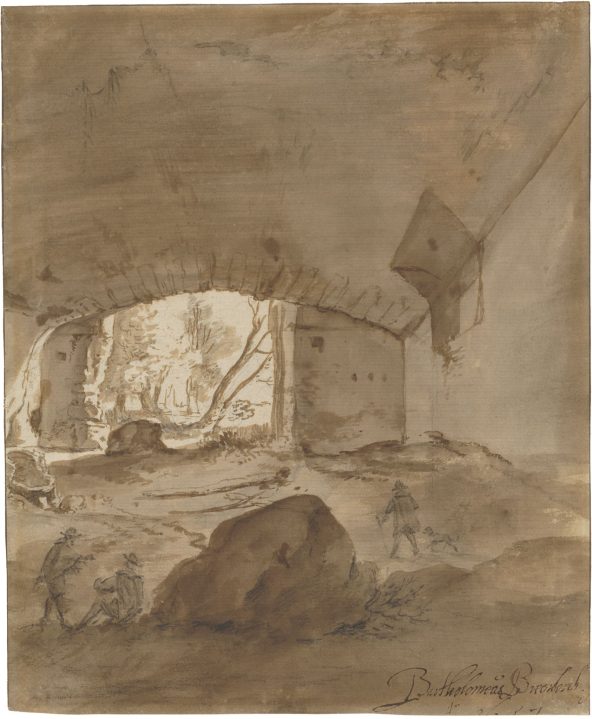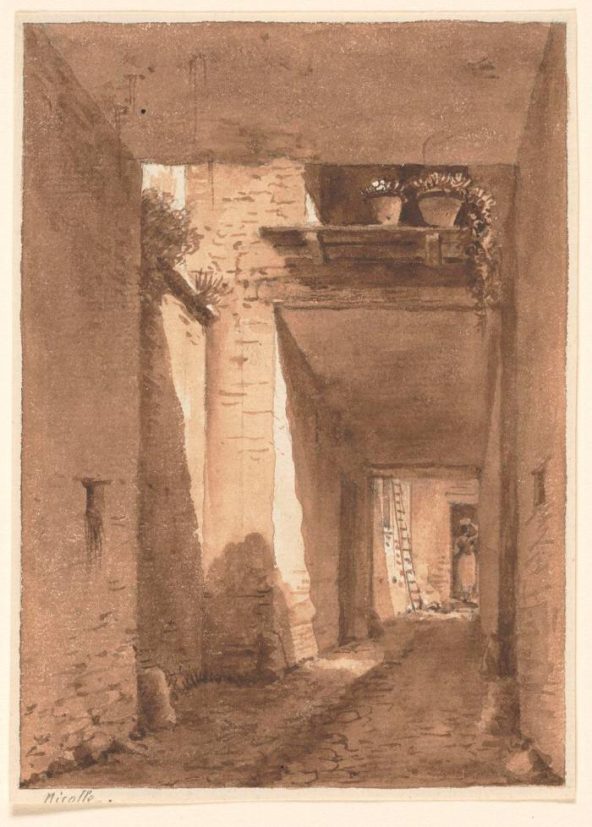Article: The Light that Illuminates the Darkness: Drawings of Italian Interiors
Focus on the Peck Feature
The contrast between light and dark has captivated artists for centuries, providing a powerful means of expression in any composition. This Focus on the Peck Collection installation features three artists that went south to Italy to experience its long history, warm atmosphere, and unique light. Although active during different periods, they each employed a similar use of wash, or diluted ink, to consider how light transforms a space, whether in the shaded inner confines of a large vault, a narrow corridor, or a grand passageway.
The contrast between light and dark has captivated artists for centuries, providing a powerful means of expression in any composition. This Focus on the Peck Collection installation features three artists who explored the theme of interior spaces punctuated by brilliant sunlight. Each drawing demonstrates the artists’ varying use of wash, or diluted ink, to depict their subjects, whether it be the shaded inner confines of a large vault, a narrow corridor, or a grand passageway.
Although active during different periods of time, Dutch artist Bartholomeus Breenbergh and French artists Victor Jean Nicolle and Paul Émile Detouche all traveled from the north to Italy to experience its long history, warm atmosphere, and unique light. Attracted by the human-made structures of the past, they employed similar techniques in different styles to consider the ways in which light transforms architectural spaces, presenting contemplative, yet evocative scenes.
View Under an Archway or Inside a Vault

Bartholomeus Breenbergh, Dutch, 1595 – 1657, View from Inside a Vaulted Chamber, Possibly the Villa of Maecenas in Tivoli, 1657, pen and brown ink, brown wash, and black chalk. The Peck Collection, 2017.1.13
Landscape painter Bartholomeus Breenbergh found inspiration in the natural and human-made tunnels, caverns, and vaults he encountered while living in Italy during the 1620s. He, like other Dutch artists, continued to depict the Roman countryside and golden light of the Mediterranean after his return to the Netherlands. Bold in its execution, this drawing was produced almost entirely with varying shades of wash, or diluted ink. The dark, cool atmosphere of the interior space encompasses most of the composition, yet the focus of the work rests on the sunshine and warmth just beyond the large entryway. Although the date is cut off at the lower edge, the drawing likely dates to the last year of Breenbergh’s life, suggesting Italy’s enduring influence on the artist.
Scene in Italy

Victor Jean Nicolle, French, 1754 – 1826, Scene in Italy, 1787-99 or 1806-11, brown wash over graphite. The William A. Whitaker Foundation Art Fund, 81.18.1
See Scene in Italy in more detail here.
Victor Jean Nicolle travelled twice to Italy during his career and became known for his architectural views of Rome. This drawing illustrates his study of light as it strikes the inner wall of a shaded corridor. Like Bartholomeus Breenbergh (above) and Paul Émile Detouche (below), Nicolle created form through varying shades of brown wash to invoke a still and quiet atmosphere. Sprouting plants, flowerpots, and a ladder activate the otherwise empty space while the woman standing at the end of the passageway signals the ordinary routine of daily life.
View of Rome

Paul Émile Detouche, French, 1794 – 1874, View of Rome, 1820, watercolor over graphite. Gift of the Ackland Associates, 79.57.5
See View of Rome in more detail here.
Paul Émile Detouche traveled to Italy as a young man and likely produced this drawing while on a study trip. It depicts a stone vaulted walkway that leads to an inner courtyard where sunlight casts a long shadow on a distant building, suggesting midday. With controlled precision, Detouche described the architectural elements and used gradually lighter applications of wash to imply distance. The grand, empty spaces evoke the historical past while the emphasis on symmetry, geometry, and proportion recall the ideals of Renaissance classicism, an artistic style that inspired many French artists at this time.
